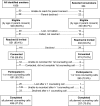Design and implementation of an effective telephone counseling intervention for adolescent smoking cessation
- PMID: 19822837
- PMCID: PMC2765262
- DOI: 10.1093/jnci/djp318
Design and implementation of an effective telephone counseling intervention for adolescent smoking cessation
Abstract
Background: Effective smoking cessation for youth is urgently needed, but the literature guiding such efforts is nascent. We evaluated the implementation of a proactive intervention for adolescent smoking cessation that incorporated motivational interviewing (MI) and cognitive behavioral skills training (CBST).
Methods: We proactively identified 1058 smokers via classroom survey of enrolled juniors in 25 experimental high schools. After parental consent was obtained, trained counselors telephoned participants to invite their participation and deliver personalized smoking cessation counseling that combined MI and CBST. Implementation quality was assessed via weekly supervision of counselors, monitoring of counselor adherence to protocol via review of 5% of each counselor's calls, and formal evaluation of counselor fidelity to MI via review of a random sample of 19.8% of counseling calls using the Motivational Interviewing Treatment Integrity Code.
Results: Among identified smokers, 948 (89.6%) were eligible for intervention by age (> or =18 years) or parental consent, 736 (70%) agreed to participate in telephone counseling, 691 (65%) completed one or more counseling calls, and 499 (47%) completed all planned calls. Telephone delivery of the personalized MI and CBST counseling intervention to a general population of adolescents was done with greater than 90% adherence to the intervention protocol. Review of the random sample of counselors' calls demonstrated that more than 85% of counselors' calls met or exceeded benchmark scores for four of six evaluated behaviors: MI spirit (99.1%), empathy (96.2%), ratio of reflections to questions (97.2%), and MI adherent (85.7%).
Conclusion: An effective proactive telephone counseling intervention consisting of MI and CBST can be successfully implemented with reach and fidelity in a general population of adolescent smokers.
Figures
Comment in
-
Helping adolescent smokers quit: can telephone quitlines lead the way?J Natl Cancer Inst. 2009 Oct 21;101(20):1367-8. doi: 10.1093/jnci/djp333. Epub 2009 Oct 12. J Natl Cancer Inst. 2009. PMID: 19822835 No abstract available.
References
-
- Sussman S, Sun P, Dent CW. A meta-analysis of teen cigarette smoking cessation. Health Psychol. 2006;25(5):549–557. - PubMed
-
- Backinger CL, Michaels CN, Jefferson AM, Fagan P, Hurd AL, Grana R. Factors associated with recruitment and retention of youth into smoking cessation intervention studies—a review of the literature. Health Educ Res. 2008;23(2):359–368. doi:10.1093/her/cym053. - PubMed
-
- Backinger CL, McDonald P, Ossip-Klein DJ, et al. Improving the future of youth smoking cessation. Am J Health Behav. 2003;27(suppl 2):S170–S184. - PubMed
Publication types
MeSH terms
Grants and funding
LinkOut - more resources
Full Text Sources
Medical
Miscellaneous




